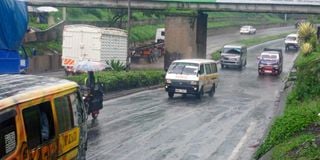KenHa plans fix for flood-prone Cigma underpass in Nakuru

Underpass at gate iguru near Cigma building in Nakuru that often floods making the road impassable. Photo taken on May 27,2025.
After heavy rainfall, motorists travelling into and out of Nakuru city via the Nakuru-Nairobi highway often dread the section near the flyover.
You see this stretch frequently floods, rendering it impassable for vehicles.
Last year, Mtaa Wangu ran a story highlighting the plight of motorists affected by the flooding.
Several shared harrowing experiences, including getting punctures and, in some cases, water seeping into their engines—leading to costly repairs.
In an interview with Mtaa Wangu, Eng. Kibet Terigin, the Corridor B Director at the Kenya National Highways Authority (KeNHA), explained the root of the issue.
“In the past, we didn’t experience problems with that section of the road. However, due to human activities upstream in areas such as Milimani, we are now receiving significantly higher volumes of storm water flowing into that drainage,” says Eng. Terigin.
He further notes, “The current drainage capacity is no longer sufficient to accommodate the increased water flow. That, coupled with siltation only worsens the situation.”
Nakuru’s Roads Executive Eng. Michael Karanja on his part says that at the lowest part of the bridge there is an intake chamber and a tunnel.
“The tunnel has culverts of 0.9 meters wide. Those culverts were installed in the pre-colonial era. Fast forward to today; we have paved more surfaces, built houses and other such activities. Therefore, the water that was absorbed by the ground now flows freely along the tarmac roads and pavements since there is no ground to absorb it. So while the water that flows on the surface has increased, the drainage in itself has not increased in size,” he notes.
To mitigate the problem, KeNHA has implemented temporary measures aimed at minimizing flooding in the area.
“For now, as a temporary solution, we ensure the drains are cleaned immediately after it rains to prevent clogging and further flooding,” Eng Terigin says.
He mentions that long-term improvements are in the planning phase through an upcoming Public-Private Partnership (PPP), which will provide the necessary funding to expand the drainage capacity
“The storm water flowing through that area travels through a school, a bus park, and a market before eventually reaching Lake Nakuru. This makes it a major storm water outfall passing right through the town. The existing system is an underground drain, and upgrading it would require significant investment,” he explains.
As he concludes, Eng. Terigin urges motorists to exercise caution when approaching the affected section of the highway when it floods before a permanent solution is found.
He also encourages motorists to consider using alternative routes when possible, assuring the public that advisories will be issued whenever the situation becomes severe.


